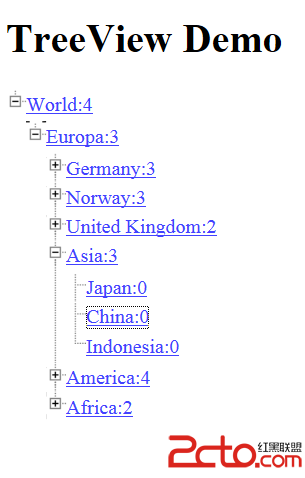Heim >Backend-Entwicklung >PHP-Tutorial >PHP-Entwicklungsframework Yii Framework-Tutorial (19) UI-Komponente TreeView-Beispiel
PHP-Entwicklungsframework Yii Framework-Tutorial (19) UI-Komponente TreeView-Beispiel
- 黄舟Original
- 2017-01-21 10:31:001179Durchsuche
CTreeView wird zum Anzeigen hierarchischer Daten verwendet, indem TreeView durch Festlegen der Data-Eigenschaft verwendet wird. Daten sind ein Array mit der folgenden Struktur:
ext: string, der Text des Baumknotens.
expanded: boolescher Wert, optional, der angibt, ob der Knoten erweitert ist.
id: Zeichenfolge, optional, die Knoten-ID.
hasChildren: boolean, optional, der Standardwert ist False. Wenn True, bedeutet dies, dass der Knoten untergeordnete Knoten enthält.
Kinder: Array, optional, Array von untergeordneten Knoten.
htmlOptions: Array, HTML-Optionen.
Bisher haben wir das Lesen der Datenbank noch nicht eingeführt, daher lauten die Daten mit Hardcode in diesem Beispiel wie folgt:
array( 'text' => ' 'id' => '27' , 'hasChildren' => true, 'children' => array ( array( 'text' => ' 'id' => '1' , 'hasChildren' => true, 'children' => array ( array( 'text' => ' 'id' => '3' , 'hasChildren' => true, 'children' => array ( array( 'text' => ' 'id' => '15' , 'hasChildren' => false, ), array( 'text' => ' 'id' => '16' , 'hasChildren' => false, ), array( 'text' => ' 'id' => '5' , 'hasChildren' => false, ) )), array( 'text' => ' 'id' => '2' , 'hasChildren' => true, 'children' => array ( array( 'text' => ' 'id' => '10' , 'hasChildren' => false, ), array( 'text' => ' 'id' => '12' , 'hasChildren' => false, ), array( 'text' => ' 'id' => '11' , 'hasChildren' => false, ))), array( 'text' => ' 'id' => '4' , 'hasChildren' => true, 'children' => array( array( 'text' => ' 'id' => '13' , 'hasChildren' => false, ), array( 'text' => ' 'id' => '14' , 'hasChildren' => false, ))), array( 'text' => ' 'id' => '7' , 'hasChildren' => true, 'children' => array ( array( 'text' => ' 'id' => '18' , 'hasChildren' => false, ), array( 'text' => ' 'id' => '20' , 'hasChildren' => false, ), array( 'text' => ' 'id' => '19' , 'hasChildren' => false, ) )), array( 'text' => ' 'id' => '9' , 'hasChildren' => true, 'children' => array ( array( 'text' => ' 'id' => '23' , 'hasChildren' => false, ), array( 'text' => ' 'id' => '24' , 'hasChildren' => false, ), array( 'text' => ' 'id' => '25' , 'hasChildren' => false, ), array( 'text' => ' 'id' => '26' , 'hasChildren' => false, ))), array( 'text' => ' 'id' => '8' , 'hasChildren' => true, 'children' => array( array( 'text' => ' 'id' => '22' , 'hasChildren' => false, ), array( 'text' => ' 'id' => '21' , 'hasChildren' => false ) ) ) )))));
Hier wird dem Text jedes Knotens ein Link hinzugefügt. Gleichzeitig wird auch die Verwendung von JQuery zum Reagieren auf Knotenklickereignisse demonstriert, was durch clientseitige JavaScripts erreicht wird.
Ansichtsdefinition ändern
$cs=Yii::app()->clientScript;
$cs->registerScript('menuTreeClick', "
jQuery('#menu-treeview a').click(function() {
alert('Node #'+this.id+' was clicked!');
return false;
});
");
$this->widget('CTreeView',array(
'id'=>'menu-treeview',
'data'=>DataModel::getDummyData(),
'control'=>'#treecontrol',
'animated'=>'fast',
'collapsed'=>true,
'htmlOptions'=>array(
'class'=>'filetree'
)
));
?>registerScript von clientScript wird zum Definieren clientseitiger JavaScripts verwendet.

Das Obige ist der Inhalt des PHP-Entwicklungsframeworks Yii Framework-Tutorial (19) UI-Komponente TreeView-Beispiel Weitere verwandte Inhalte finden Sie auf der chinesischen PHP-Website ( www.php.cn)!
In Verbindung stehende Artikel
Mehr sehen- So verwenden Sie cURL zum Implementieren von Get- und Post-Anfragen in PHP
- So verwenden Sie cURL zum Implementieren von Get- und Post-Anfragen in PHP
- So verwenden Sie cURL zum Implementieren von Get- und Post-Anfragen in PHP
- So verwenden Sie cURL zum Implementieren von Get- und Post-Anfragen in PHP
- Alle Ausdruckssymbole in regulären Ausdrücken (Zusammenfassung)

